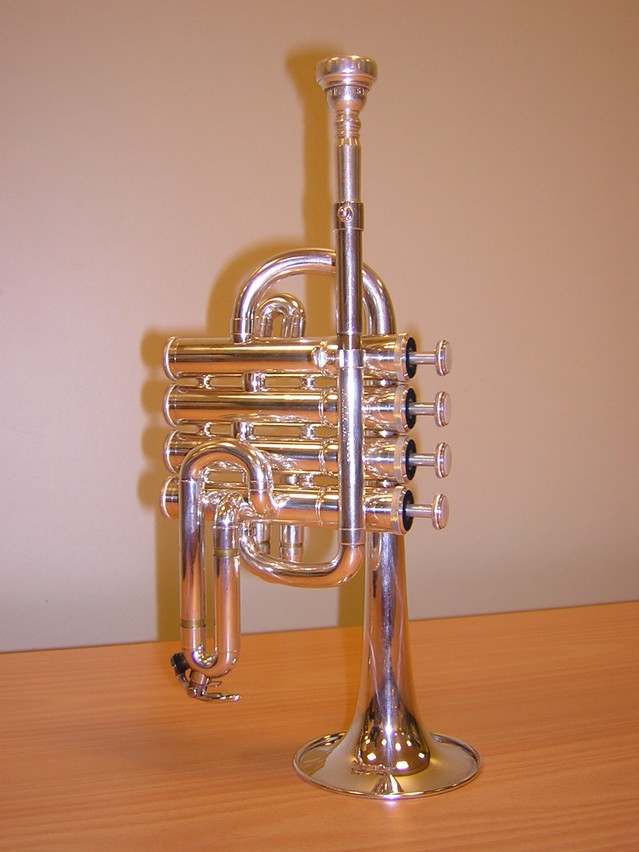Is it a Piccolo or is it a Trumpet? Can I become a screamer overnight? Sorry to say these were the first things that I thought about when I first heard of a Piccolo Trumpet. So what is it, really? In my mind, the Piccolo Trumpet is to the trumpet, what the piccolo is to the flute. It’s the smallest of the different trumpets you can find and much brighter in tone. The bell is smaller, around 4” in diameter. The bore size is smaller as well. It is higher in pitch by a full octave. That means if you play a “C” in the middle of the staff on your trumpet, it would be a “C” above the staff on the Piccolo Trumpet. The Piccolo Trumpet also doesn’t have a main tuning slide as your regular trumpet. It has a removable shank mouthpiece receiver just like your Flugelhorn. Most Piccolo Trumpets come with two removable shank receivers that allow you to play it in the key of B-Flat or A.
Table of Contents
- What Does A Piccolo Trumpet Look Like?
- Is Piccolo Trumpet Hard To Play?
- Piccolo Trumpet Solos
- Penny Lane and the Piccolo Trumpet
- Piccolo Trumpet Range
- Piccolo Trumpet Mouthpiece
- What Is The Best Piccolo Trumpet?
What Does A Piccolo Trumpet Look Like?
It’s not just a small, regular trumpet. Meaning, the length of the total tubing is way less, like almost half of your B-flat regular trumpet. The Piccolo Trumpet has it’s leadpipe go into the fourth valve where your B-flat trumpet has your leadpipe going into the third valve. Yes, it’s a small trumpet, but it’s been designed and plays differently than your regular trumpet. You’ll notice that the tubing in the valves are roughly half the length of your regular trumpet. It’s also much brighter. The first thing you’ll notice is that most Piccolo Trumpets have 4 valves where your trumpet has 3. The reason is that the 4th valve allows you to play lower since you’ll be playing up an octave from your trumpet. The 4th valve tubing is equal to the tubing length of the first and third valve tubing. So why a fourth valve? It helps with slotting and the intonation in the lower register (meaning, at the lower part of the staff and lower).
Is Piccolo Trumpet Hard To Play?
If you are comparing it to your regular, B-flat trumpet, than “kinda”. I found it harder because the Piccolo Trumpet accepts a lot less air than my regular trumpet, medium large bore B-flat trumpet. Even with the same mouthpiece. I found that if I took my regular, full breaths, I couldn’t get all that air through the Piccolo Trumpet before I needed to breathe. After a short while of trying this (incorrect) way to play it, I got lightheaded. I found that taking smaller breaths worked much better. You may also find exhaling a bit where you would normally breath in helps. Also, when you practice, do it in shorter sessions than your regular trumpet as it takes a lot of effort since you are playing in the upper register. I found that warming up on my regular trumpet and then playing the Piccolo Trumpet helped a ton. Also, after playing the Piccolo Trumpet, I would warm down on my B-flat trumpet and my chops didn’t feel beat up.
You will also find that your tonguing has to be a little lighter. If you think “Ta Ta Ta” like your regular trumpet, you’ll cut off your air and notes too much. This is because your airstream is less than your regular trumpet. I found keeping the tip of my tongue in contact with my lower teeth in the beginning helped me as I learned to play the Piccolo Trumpet.
The Piccolo Trumpet also requires that you transpose music into different keys. That is something I’m not gifted at, but you may be. It’s for these reasons I say, yea, it’s “kinda” hard. But like the trumpet, after you practice and learn how to play a Piccolo, it’s a fun instrument with a really unique sound. Bottom line, the Piccolo Trumpet is for you if you are a more advanced trumpet player. It’s also for you as you become a more advanced player.
Piccolo Trumpet Solos
Most Piccolo Trumpet solos are classical pieces. Maurice Andre, the legendary French Trumpeter is most famous for his recording of over 300 compositions.. Much of his work is Baroque music and his mastery of the Piccolo Trumpet gave it a ton of popularity.
Alison Balsom is also making a name for the Piccolo Trumpet.
Penny Lane and the Piccolo Trumpet
This is probably the song where the Piccolo Trumpet became most recognizable by the modern public because of the Beatles. “Penny Lane” was recorded in 1967 and was released as a “Double A” sided single with the Beatles “Strawberry Fields Forever” song. This release became one of the most famous in history. Before this the Piccolo Trumpet was only used in classical music, Holiday music, etc. Paul McCartney was watching television and heard Bach’s 2nd Brandenburg Concerto #2 in F Major. He heard this bright, clean, brilliant sounding trumpet that intrigued him. The trumpet player he saw, was Dave Mason. He called Dave the next day and got together. Dave said he brought 9 different trumpets. He admits he really didn’t know the Beatles very well at the time. Mason ended up playing a B-flat Piccolo Trumpet which Paul McCartney added in after the rest of the Beatles had recorded “Penny Lane”. Like many, it was the first time I’d ever heard the Piccolo Trumpet.
Penny Lane Trumpet Sheet Music
Penny Lane by B_ShofPiccolo Trumpet Range
When I first heard a Piccolo Trumpet, I thought “wow, I can scream on that thing”. I couldn’t have been more wrong. I was looking for a shortcut to play higher when I was younger and later learned that a Piccolo Trumpet won’t turn you into a screamer overnight. For the reasons above (mostly the amount of air you can put into the horn) it takes as much or more effort to play a Piccolo Trumpet than your regular trumpet.
On your regular trumpet, notes above “C” above the staff are out of the normal harmonic range (playable range) of the horn. So it takes a bit of control to hit and maintain them as the notes are closer together. On the Piccolo Trumpet, that same high “C” is within it’s harmonic range so the notes are further apart. You’ll notice a bigger difference in the slotting of notes above the register than on your regular trumpet. On one hand, it takes less control to hit and maintain those notes, but they aren’t a ton easier than on your regular trumpet.
Piccolo Trumpet Mouthpiece
Most Piccolo Trumpet players use their “Lead” trumpet mouthpiece. The reason is that the Piccolo Trumpet’s range is an octave higher, so a shallower cup helps. Also, many lead trumpet mouthpieces have a smaller backbore or throat which also helps as the smaller horn can’t take as much air as your regular trumpet. I found that using a mouthpiece with the same or similar cup diameter made the transition from a deeper cup mouthpiece worked best. Check out our recommendations for the Best Lead Trumpet Mouthpieces.
Affiliate disclosure: As an Amazon Associate we earn qualifying purchases. This is to help support this site. This means if you click on links on reviewed products, we may earn a small commission on your purchase from Amazon. Please note that your price does not increase because of this. Thank you in advance for supporting the band.
What Is The Best Piccolo Trumpet?
Best Piccolo Trumpet – Top Pick
Schilke Piccolo Trumpet- Schilke Music Products has been making brass instruments since 1956. Based in Chicago, the founder Renold Schilke designed and built mouthpieces and brass instruments. At the age of 17, he went to Brussels, Belgium to study at the Brussels Conservatory. He started learning about 18th century techniques for controlling the intonation of brass instruments by differences in the taper of the tubes used. His first instruments back then were b-flat trumpets, E-flat trumpets, and Piccolo Trumpets. His designs and quality focus on his instruments were so influential in the industry, that when Yamaha wanted to get serious about producing great brass instruments, they hired Renold Schilke as a consultant in 1967. Many of his designs and innovations are still in use today by Yamaha and others. Schilke built their first Piccolo trumpet in 1966. Schilke makes trumpets, cornets, flugelhorns, French horns, trombones, and mouthpieces.
The Schilke P5-4
The Schilke P5-4 has long been considered the “Reference Standard” Piccolo Trumpet by trumpet players and the musical instrument industry in general. The design and refinements that Schilke has put into their Piccolo Trumpet designs over the past 6 decades gives this model exceptional intonation and playability. It has a larger bore size of 0.450 inches where most others have the smaller 0.415 inch bore. This lets it accept more air so you can support your notes better which makes playing in tune a bit easier. One unqiue feature that really separates this Piccolo Trumpet is that it is built with a beryllium copper bell. This harder metal gives a brighter sound to the horn. The “BG” option was designed for Barbara Butler and Charles Geyer from Rice, Shepard School of Music. The BG option also adds a removable 4th slide with a slide ring. This option also includes a 1st valve slide saddle. All four valves are Monel. It comes with a Silver-plated finish. This top pick comes with a lifetime warranty from Schilke.

Best Piccolo Trumpet – Overall Performer
Bach Stradivarius Piccolo Trumpet. The Vincent Bach Stradivarius AP190 Artisan Series Piccolo Trumpet. This Bach Stradivarius has a bore size of 0.450 inches like the Schilke P5-4 above. Like all Bach Stradivarius trumpets, the one-piece, yellow brass bell is hammered by hand and specifically annealed to produce that unique Bach Stradivarius sound. Like the 50th Anniversary Bach Stradivarius Trumpets, it comes with both nylon and brass valve guides. The valve cluster is also made like those Stradivarius Trumpets of old, made with nickel balusters and brass casings for the hand-lapped, Monel valves. The AP190 comes with four removable mouthpiece receivers. Two each for trumpet and cornet mouthpieces for the keys of B-flat and A. I didn’t notice as much of a difference in the color of the tone between the lacquer finish or the silver plated finish like with their B-flat trumpets. The finishes aren’t that different in price (less than 4% more for the silver plated finish) so I’d recommend the silver plated finish over the lacquer for the longevity of the finish. Like all Bach Instruments, it comes with their 5 year warranty.

Hope this helps you with your trumpet playing. Please let us know what Piccolo Trumpet you play. As always, thanks for playing along.


